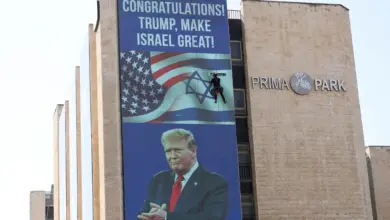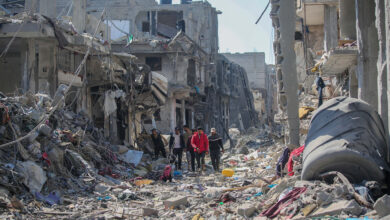Best known by the moniker the Narcicyst, artist Yassin Alsalman demonstrates the possibilities of non-violent resistance through hip-hop. The Iraqi-Canadian musician utilizes his lyrical talent and personal experiences to create intellectually provocative music while maintaining an unusually sharp sense of humor. He, and his sometimes collaborator, British-Palestinian Shadia Mansour, are part of a growing movement of expat Arab artists committed to taking action through art.
Shaped by his experiences as an Arab living in North America, Alsalman’s musical topics range from confrontations with Islamophobia, reflections on the attacks of September 11, and criticism of the Israeli occupation of Palestine. And throughout much of Alsalman’s work, the artist carries a conviction to criticize and create awareness regarding the destruction of Iraq since the 2003 US-led invasion.
In his Twitter biography, the Narcicyst describes himself as a “Pop Culture Enthusiast and Arab Culture Humorist,” but such descriptions don’t seem to do justice to his many accomplishments. The musician has completed a master’s degree in media studies with a focus on Arab musical identity, scored the 2004 documentary “Voices of Iraq,” and works as a journalist and educator.
Far from the superficiality of much mainstream music, Alsalman’s music concerns Arab identity and political justice. Lyrics such as “I’m sorted out from the beardless cats that boarded the plane as I was boarding,” depict the artist’s experience with racial profiling.
Reflective of his roots in both Iraq and Canada, the Narcicyst raps in both English and Arabic, allowing him to reach a wide, international audience. Artist and collaborator, Shadia Mansour, on the other hand, prioritizes lyrics in Arabic. The Narcicyst’s award-winning song “Hamdulillah” features a beautiful, undulating hook by the London-based Mansour. The British-born Palestinian told BBC News reporter Jon Hebron that the language’s role as “the language of poetry” and a “classical language” formed part of her choice to focus on Arabic in her song-writing.
Alsalman focuses on his Iraqi identity and Mansour on the Israeli occupation of Palestine, but both call for non-violent resistance. Mansour also touches upon Arab unity, as in her song, “Kofeyye” (Enough). A musical attempt to explain the historical, political and revolutionary symbolism of the scarf (which she is pictured here wearing, in a still from the music video for "Hamdulillah"), Mansour wants to reclaim the clothing item from its recent international commercialization.
“Hamdulillah” marks a successful collaboration between the two, highlighting their international focus. The video features footage of Alsalman, sporting both a vibrant red fez and thick-rimmed glasses, and Mansour singing, and flashes through the diverse faces of an international community. A woman with a tightly tied beige veil; a young lady wearing a chunky, yellow necklace; a toddler sucking on his finger in the arms of his father–all face the camera in solidarity.
Posted over 150,000 times on Facebook, the video has enjoyed considerable acclaim and was recently awarded “Best Video of the Year” in Montreal’s 2010 Hip-Hop Awards. In response, Alsalman wrote on his blog that this song and video is about community, created by all its members, perhaps referencing the reciprocal process of his creative expression and activism. The message of “Hamdulillah,” however, extends beyond the confines of Alsalman’s personal network to address a global one. Alsalman addresses this specifically when he writes on his blog that the song is about “gratitude, faith and deliverance through your community.” The video calls for recognition of a universal humanity.
In an interview on New York-based Radio Tahrir, Mansour also spoke to a larger community, avoiding labels. “I’m not just an artist. I’m an activist, and I’m a human being.”




